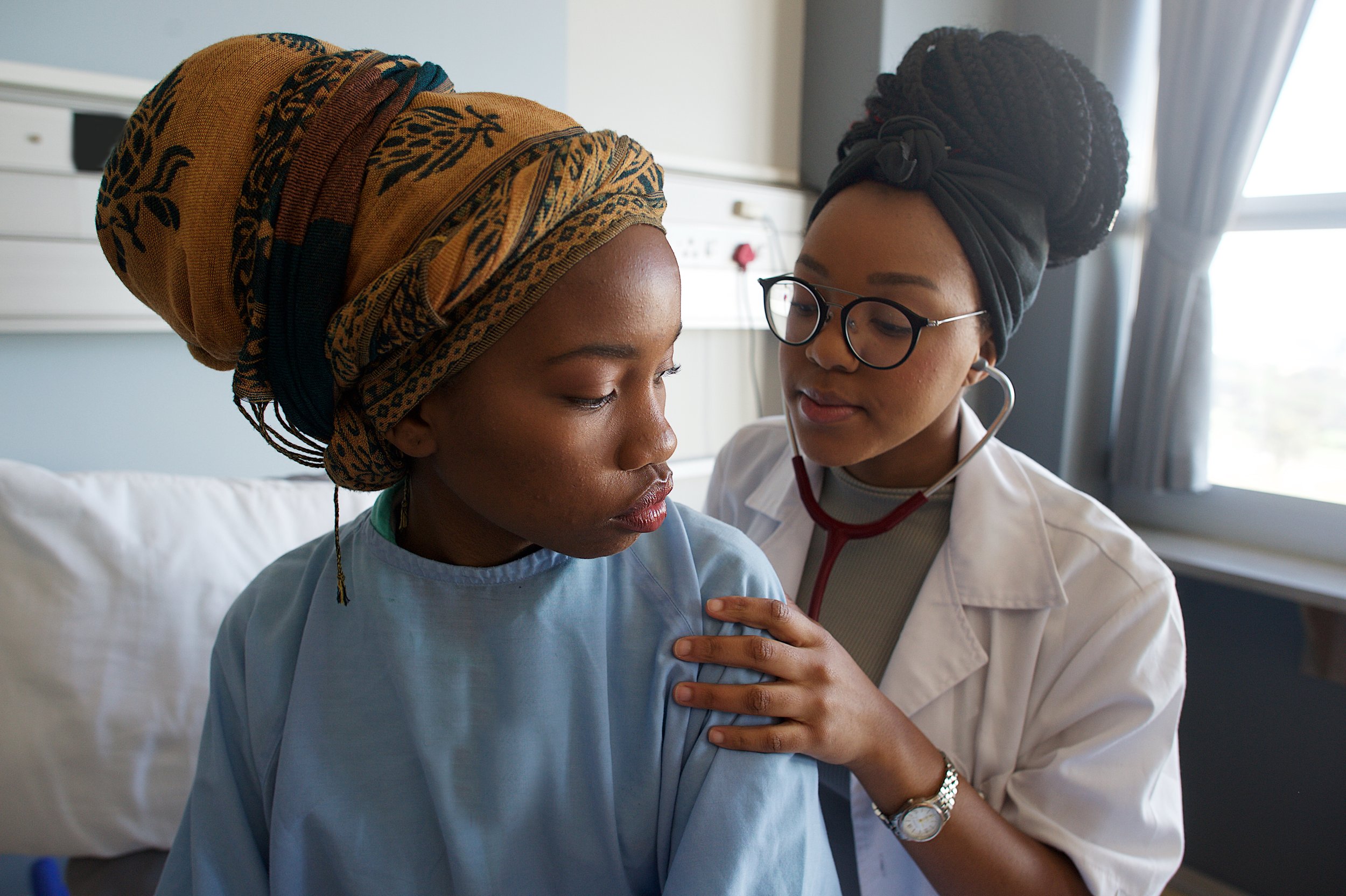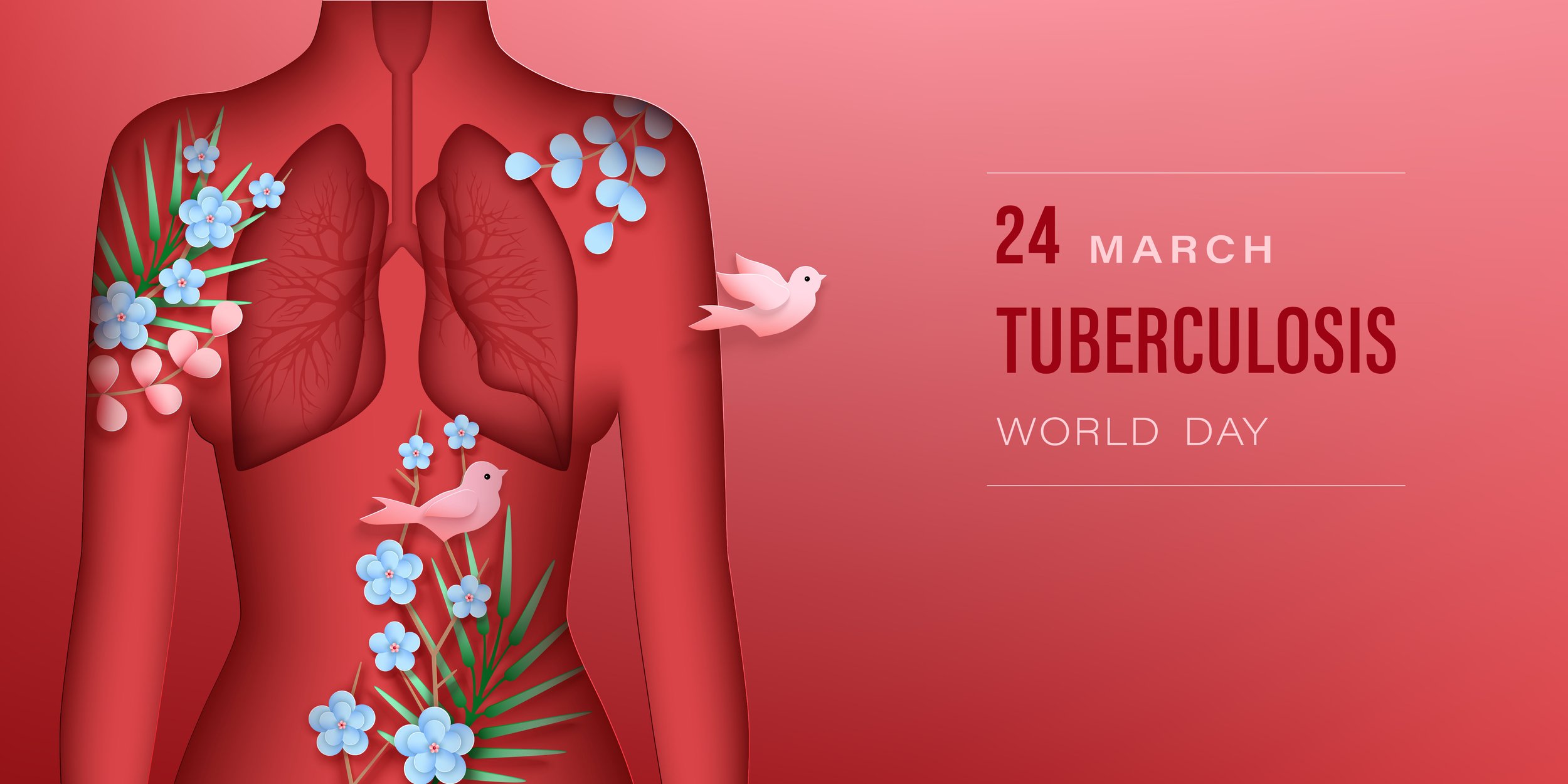The Devastating Impact of Misdiagnosed and Delayed Tuberculosis Treatment
My journey with TB was a long-drawn one. Throughout my teenage years, I was persistently unwell. I recall my siblings cautioning me against playing outdoors, fearing it would worsen my cough. I relied on over-the-counter medications to alleviate what seemed like an endless flu or a stubborn cough. Occasional visits to local clinics in my small town would provide temporary relief, but the cough always returned.
A Doctor listens with a stethoscope on a patient's back in a hospital ward in Cape Town, South Africa | Credit: wilpunt
The situation escalated when I was fifteen. During my third term break, I rapidly lost weight, and my body began to contort around the chest area. I couldn’t sit upright, and my cough worsened to the point where it echoed throughout the village from my bedroom in my parent’s house. The pain was unbearable.
I had resigned myself to living with a chronic chest condition, believing that while I may never fully recover, medication could help me manage the disease.
Driven by a desire for a more comprehensive diagnosis, my mother decided to take me to a more specialized hospital. The challenging journey to the hospital, approximately 34 km away, underscored the importance of healthcare accessibility in achieving universal health coverage and combating diseases like TB.
We spent the first day waiting, with the few available doctors fully engaged. The next day, I underwent a sputum test, which seemingly ruled out TB, followed by a chest X-ray. At my tender age, the full implications of my diagnosis eluded me, but I was prescribed a syrup designed to expand the air tubes leading to my chest. A follow-up appointment was scheduled for three days later.
The next appointment introduced me to a different doctor, a chest specialist. One look at my Chest X-ray and her mouth went agape. “She has TB,” she declared, “which has caused quite a lot of damage to the chest.” My mother, the strongest woman I know, was visibly shaken. It was the first time I saw fear and anxiety in her eyes. As she excused herself from the examination room, I grappled with the paradox of my situation. Here, I was diagnosed with a curable disease, yet my mother looked quite upset. Why?
With time, the pieces fell into place.
“I had resigned myself to living with a chronic chest condition, believing that while I may never fully recover, medication could help me manage the disease.”
Today, March 24th, we commemorate a pivotal moment in medical history. On this very day in 1882, Dr. Robert Koch made a groundbreaking revelation to the world- the identification of the bacterium that causes tuberculosis (TB). This discovery laid the groundwork for the diagnosis and treatment of this deadly disease.
TB, a contagious disease that is both preventable and curable, is caused by the Mycobacterium tuberculosis (Mtb) bacteria. The disease is transmitted through the air when an infected individual coughs, speaks or sings. Those nearby may inhale these bacteria, potentially leading to infection.
This day holds different meanings for different people. For some, it serves as a stark reminder of the devastating impact of this disease. For others, it is a day to honor the memory of countless lives lost to TB. Yet, for many, it symbolizes our significant strides in combating this disease. For me, this day carries a deeply personal significance.
Tuberculosis is the second leading infectious killer after COVID-19, surpassing HIV and AIDs. Each day, over 3,500 people lose their lives to TB, and close to 30,000 people fall ill with this preventable disease. In 2022 alone, 1.3 million people died from TB, including 167,000 people with HIV. Globally, 10.6 million people fell ill with TB that year, including 5.8 million men, 3.5 million women, and 1.3 million children. Given this staggering impact, it’s unsurprising that over the past two centuries, TB has claimed more than a billion lives. This death toll surpasses the combined fatalities from malaria, influenza, smallpox, HIV/AIDS, cholera, and plague.
Each day, over 3,500 people lose their lives to TB, and close to 30,000 people fall ill with this preventable disease.
|
Each day, over 3,500 people lose their lives to TB, and close to 30,000 people fall ill with this preventable disease. |
My personal experience with delayed diagnosis of TB is not an isolated incident. A 2022 study revealed that such delays are a significant factor in the high fatality rate from TB worldwide. The study analyzing 16 case studies found that across countries with high TB burden, only 38% of patients with TB symptoms were offered a TB test.
Despite the International Standards for Tuberculosis Care recommending that all patients with an unexplained cough lasting two weeks be investigated for TB, screening was reportedly not conducted for 34 to 96% of symptomatic participants in five studies. Another study found that individuals presenting with cough, fever, and night sweats - the primary symptoms of TB - were more likely to delay seeking TB care. This delay was often because these symptoms were mistaken for other respiratory infections. Interestingly, the study also found that while TB predominantly affects men, women in some settings faced more hurdles in accessing TB care promptly. These challenges stemmed from resource constraints, power imbalances, and a lack of knowledge about TB.
Additional factors contributing to delayed TB diagnosis include language barriers in migrant settings, a lack of facilities offering TB diagnostic services in rural areas, poor awareness of TB care policies among patients, misconceptions and stigma associated with TB diagnosis, and subpar healthcare quality in both public and private hospitals.
The treatment phase was my perfect storm. It wasn’t just the physical toll of the disease or the eight months of medication that was daunting. What truly tested my resilience was the abrupt halt it brought to my life. School, a source of pride due to my good grades, was now a distant memory. My sanctuary, the world of books, had to be put on hold until I regained my health.
Don’t get me wrong, I was grateful for the prospect of recovery. However, the isolation and the side effects of the medication were a heavy burden to bear. In my desperation to return to normalcy, I stopped taking my medication to go back to school. This only extended my treatment period.
In the fight to end TB, it’s crucial to acknowledge the mental health aspect of dealing with TB. Mental illnesses are prevalent among TB patients and can lead to reduced treatment-seeking and adherence, resulting in greater morbidity and mortality. Moreover, TB can infect the central nervous system, causing neurological symptoms, and certain anti-TB medications can have psychiatric side effects.
World Tuberculosis Day 2024
Despite these challenges, the journey to eradicate TB has seen notable successes. For instance, The Global Project on Anti-Tuberculosis Drug Resistance Surveillance, hosted by WHO since 1994, is the world's oldest and largest surveillance system for tracking drug-resistant TB cases worldwide. Through routine testing and epidemiological surveys, this initiative has provided valuable insights into the prevalence and trends of drug resistance, guiding treatment strategies and resource allocation.
Notably, advancements in TB diagnosis have revolutionized detection methods. The introduction of rapid molecular tests in 2011 marked a transformative moment, as these tests enabled decentralized testing directly using sputum samples. The key advantage of these tests is their ability to deliver faster results, which facilitates the immediate commencement of treatment and helps curb the disease’s spread.
Indeed, the advent of all-oral medication regimens is also a significant milestone in TB treatment. Traditionally, TB treatment often necessitated injections, which could be challenging for patients. I recall my own experience with injections. Initially, I was prescribed oral medication, but due to a setback when I discontinued the medication, I had to undergo a period of treatment with injections. However, the WHO's introduction of new treatment regimens in 2020, which are entirely oral, has made treatment more user-friendly and enhanced patient compliance.
In alignment with this year's theme, "Yes! We can #End TB!", intensified efforts are necessary to eradicate this epidemic by 2030. A key focus should be closing the gap between TB diagnosis and treatment. Enhancing TB diagnosis is essential, as a significant number of cases go unnoticed, which could substantially mitigate further transmission.
Additionally, it is imperative to address patients' needs. Whether it is mental health support or other services, providing what is necessary for recovery is crucial. Let's remember that the fight against TB is not just a one-day event but an ongoing commitment.
As we observe World TB Day, remember that if you or someone close is battling TB, you are not alone. We honor your strength and are united with you in this battle.


